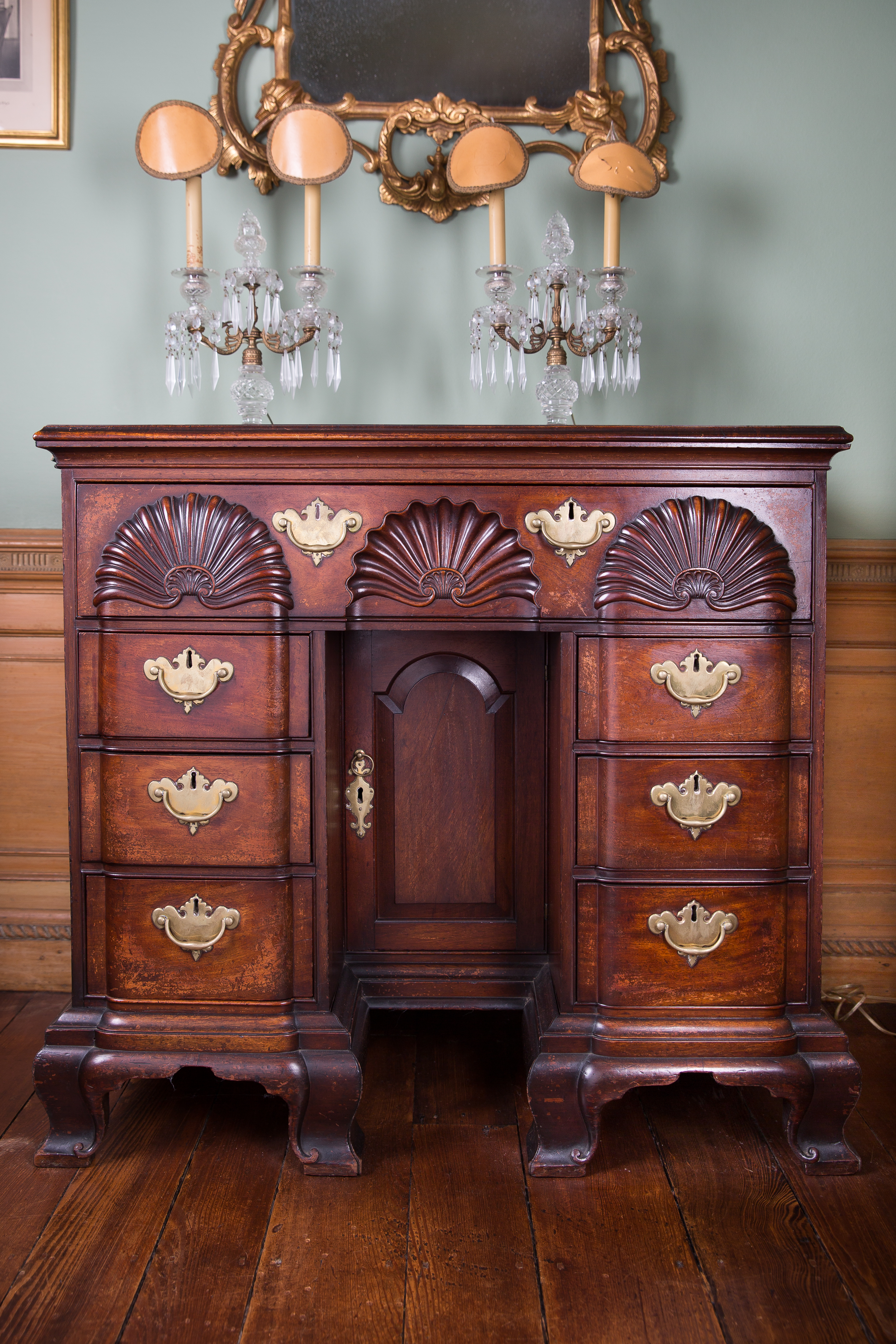Photograph of Kneehole Desk (July 2016)
Title
Photograph of Kneehole Desk (July 2016)
Description
For a short period before the Revolutionary War, Newport, Rhode Island, became a booming center for decorative arts. Furniture produced during this period, c. 1760-1775, is highly valued today, especially when associated with the Goddards and Townsends, two families of skilled craftsmen joined by marriage, religion, and proximity within a small section of Newport. Furniture made in Newport during this period is often referred to as “Goddard-Townsend.”
Like the tall secretary desk, this kneehole desk is a fine example of expert Newport block-front cabinetmaking, a style adopted from furniture makers in Massachusetts. The traditional block-front (fashionable in the colonies between 1740-1790) consisted of a three panel design—two raised block panels surrounding a center recessed panel. Because block-front furniture required more wood and labor than other forms, and was therefore more expensive, it became a kind of colonial status symbol. Newport furniture is differentiated from other colonial block-fronts by the expertly carved ornate shells that skilled furniture-makers incorporated into the design.
With their block and shell fronts, slight overhang with a molded edge around the top, and ogee feet at the bottom, Goddard-Townsend kneehole desks present little variation, although this desk is one of few to feature a writing compartment. The recessed “kneehole” that gives the desk its name is noticeably small, lending to varied scholarship that suggests people either used these desks more often for storage than as a traditional writing surface, or that they were made specifically for women’s smaller knees.
The Browns themselves appear to have used the kneehole desk more as a storage unit than as a writing surface. In their records, they refer to it variously as a “bureau,” “dressing table,” or “chest of drawers” rather than as a “desk.” Personally, I’m partial to the belief that kneeholes like this one were crafted for a storage function rather than to serve as a traditional desk. I think you would be hard-pressed to find anyone, except maybe a child, whose knees would fit comfortably in the recessed kneehole compartment.
Like the tall secretary desk, this kneehole desk is a fine example of expert Newport block-front cabinetmaking, a style adopted from furniture makers in Massachusetts. The traditional block-front (fashionable in the colonies between 1740-1790) consisted of a three panel design—two raised block panels surrounding a center recessed panel. Because block-front furniture required more wood and labor than other forms, and was therefore more expensive, it became a kind of colonial status symbol. Newport furniture is differentiated from other colonial block-fronts by the expertly carved ornate shells that skilled furniture-makers incorporated into the design.
With their block and shell fronts, slight overhang with a molded edge around the top, and ogee feet at the bottom, Goddard-Townsend kneehole desks present little variation, although this desk is one of few to feature a writing compartment. The recessed “kneehole” that gives the desk its name is noticeably small, lending to varied scholarship that suggests people either used these desks more often for storage than as a traditional writing surface, or that they were made specifically for women’s smaller knees.
The Browns themselves appear to have used the kneehole desk more as a storage unit than as a writing surface. In their records, they refer to it variously as a “bureau,” “dressing table,” or “chest of drawers” rather than as a “desk.” Personally, I’m partial to the belief that kneeholes like this one were crafted for a storage function rather than to serve as a traditional desk. I think you would be hard-pressed to find anyone, except maybe a child, whose knees would fit comfortably in the recessed kneehole compartment.
Creator
Banks III, Jesse
Source
Digital copy created by the John Nicholas Brown Center for Public Humanities and Cultural Heritage
Date
2016-07-28
Contributor
Jennifer Shook
Rights
Rights Status Not Evaluated
Citation
Banks III, Jesse, “Photograph of Kneehole Desk (July 2016),” Digital Tours of The Nightingale-Brown House , accessed December 19, 2025, https://cds.library.brown.edu/NBHouse/items/show/67.

